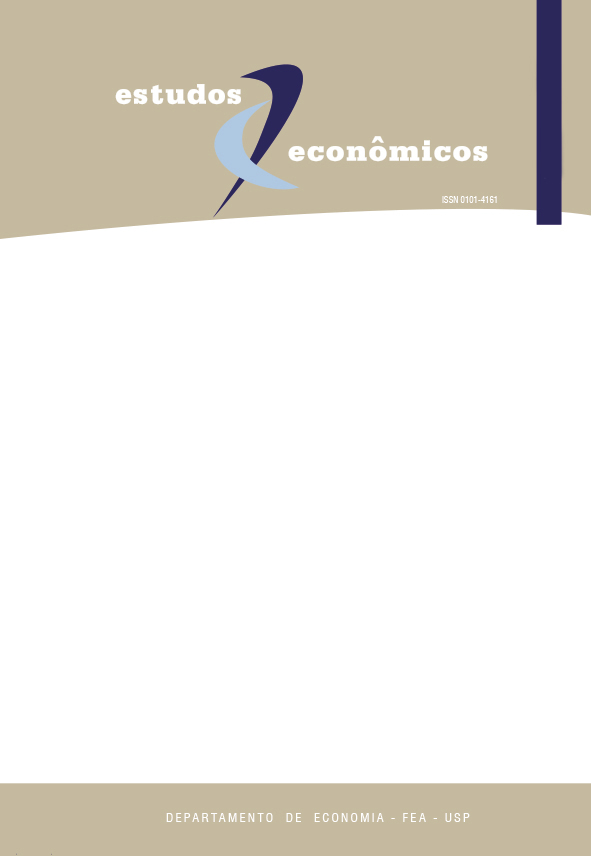Os efeitos da criação da lei da meia entrada para estudantes sobre o consumo de bens e serviços culturais no Brasil
DOI:
https://doi.org/10.1590/0101-416146471mfspPalavras-chave:
economia da cultura, lei da meia entrada, avaliação de política públicaResumo
Este trabalho estima os efeitos da implementação da lei da meia entrada sobre o consumo de bens e serviços culturais dos estudantes brasileiros, utilizando as amostras coletadas para todas as regiões metropolitanas pelas Pesquisas de Orçamento Familiar (POF), realizadas em 1987/88, 1995/96, 2002/03 e 2008/09. Avaliam-se os efeitos da lei tanto sobre a proporção de estudantes consumidores de cultura, quanto sobre os gastos dos estudantes com esse tipo de bem. Para estimar uma relação causal, explora-se as diferentes datas de criação das leis da meia entrada entre os estados brasileiros utilizando-se as metodologias de Diferenças-em-Diferenças (DD) e Diferenças Triplas (DDD). Os resultados encontrados no presente trabalho sugerem que a criação da lei da meia entrada teve efeitos positivos tanto em termos de aumento na probabilidade dos estudantes consumirem bens e serviços culturais como em elevar seus gastos com esse tipo de bem.
Downloads
Referências
ATECA-AMESTOY, V. Cultural capital and demand. Economics Bulletin, v. 26, n. 1, p. 1–9, 2007.
ATECA-AMESTOY, V. Determining heterogeneous behavior for theater attendance. Journal of Cultural
Economics, v. 32 n. 2, p 127–151, 2008.
BAUMOL, W. J., PANZAR, J. C. e WILLING, R. D. Contestable Markets: An Uprising in the Theory
of Industry Structure. The American Economic Review. v. 72, n. 1,p. 1-15, 1982
BORENSTEIN, S. Selling Costs and Switching Costs: Explaining Retail Gasoline Margins,” The RAND
Journal of Economics. v. 22, n.3, p. 354–369, 1991.
BOURDIEU, P. Cultural reproduction and social reproduction. In: Brown, Richard (Org.). Knowledge,
Education, and Cultural Change: Papers in the Sociology of Education. Londres: Tavistock,
p. 71–112.
COHEN, A. Package Size and Discrimination in Paper Towels. Working Papers University of Virginia,
Department of Economics, 2000.
COURTY, P. e PAGLIERO, M. The Impact of Price Discrimination on Revenue: Evidence from the
Concert Industry. The Review of Economics and Statistics. V.94, n.1, p.359-369, 2012.
DINIZ, S. C.; MACHADO, A. F. Analysis of the consumption of artistic-cultural goods and services in
Brazil. Journal of Cultural Economics, v. 35, n. 1, p. 1–18, 2011.
FALCK, O.; FRITSCH, M.; HEBLICH, S. The phantom of the opera: Cultural amenities, human capital,
and regional economic growth. Labour Economics, v. 18, n. 6, p. 755–766, 2011.
FARKAS, G. Cognitive skills and noncognitive traits and behaviors in stratification processes. Annual
Review of Sociology. v. 29, n.1, p. 541–562, 2003.
FAULHABER, G. R. Cross-subsidization: pricing in public enterprises. The American Economic Review,
V.65, p. 966-977, 1975.
FELTON, M.V. “On the Assumed Inelasticity of Demand for the Performing Arts”, Journal of Cultural
Economics. V. 16, n.1, p. 1-12, 1992.
GADDIS, S. M. The influence of habitus in the relationship between cultural capital and academic
achievement. Social science Research, v. 42, n. 1, p. 1–13, 2013.
GAPINSKI, J. The Economics of Performing Shakespeare. The American Economic Review. V. 74,
n.1, p. 458–466, 1984.
GREENE, W. Testing hypotheses about interaction terms in nonlinear models. Economics Letters, v.
, n. 2, p. 291–296, 2010.
HOLMES, T. J. The effects of third-degree price discrimination in oligopoly. The American Economic
Review, v. 79, n. 1, p. 244–250, 1989.
HUNTINGTON, P.A.: Ticket Pricing Policy and Box Office Revenue. Journal of Cultural Economics,
v. 17, n. 1, p. 71–87, 1993.
LAREAU, A., e HORVAT, E. M. Moments of social inclusion and exclusion race, class, and cultural
capital in family-school relationships. Sociology of Education, v. 72, n.1, p. 37–53, 1999.
LESLIE, P. Price Discrimination in Broadway Theater. RAND Journal of Economics, v. 35, n. 3, p.
-541, 2004.
LÉVY-GARBOUA, L. e MONTMARQUETTE, C. A Microeconometric Study of Theatre Demand.
Journal of Cultural Economics, v.20, n.1,p. 25-50, 1996.
McMANUS, B. Nonlinear Pricing in an Oligopoly Market: the Case of Specialty Coffee. Working Paper,
University of Virginia, Department of Economics, 2000.
MOORE, T. The Demand for Broadway Theatre Tickets. Review of Economics and Statistics. v. 48,
n.1, p. 79–87, 1966.
PAGLIOTO, B. F.; MACHADO, A. F. Perfil dos frequentadores de atividades culturais: o caso nas
metrópoles brasileiras. Estudos Econômicos, v. 42, n. 4, p. 701–730, 2012.
PORSSE, A. A.; VALIATI, L.; FLORISSI, S. (Org.). Economia da cultura: bem-estar econômico e
evolução cultural. Porto Alegre: Ed. da UFRGS, 2007.
PUHANI, P. A. The treatment effect, the cross difference, and the interaction term in nonlinear differencein-
differences models. Economics Letters, v. 115, n. 1, p. 85–87, 2012.
SCHMALENSEE, R. Output and welfare implications of monopolistic third-degree price discrimination.
The American Economic Review, v. 71, n. 1, p. 242–247, 1981.
SEAMAN, B. Empirical studies of demand for the performing arts. Handbook of the economics of art
and culture. Ed. Elsevier, v.1 p. 415-472, 2006.
SHEPARD, A. Price Discrimination and Retail Configuration. Journal of Political Economy, v. 99,
n.1,p 30–53, 1991.
THROSBY, D. Cultural capital. Journal of Cultural Economics, v. 23, n. 1-2, p. 3–12, 1999.
THROSBY, D. Economics and culture. Cambridge: Cambridge University Press, 2000.
TRAMONTE, L.; WILLMS, J. D. Cultural capital and its effects on education outcomes. Economics
of Education Review, v. 29, n. 2, p. 200–213, 2010.
VARIAN, H. R. Price discrimination and social welfare. The American Economic Review, v. 75, n. 4, p. 870–875, 1985.
Publicado
Edição
Seção
Licença
Copyright (c) 2016 Marcos Vinicio Wink Junior, Felipe Garcia Ribeiro, Stefano Florissi, Pedro Tonon Zuanazzi

Este trabalho está licenciado sob uma licença Creative Commons Attribution-NonCommercial 4.0 International License.
A submissão de artigo autoriza sua publicação e implica o compromisso de que o mesmo material não esteja sendo submetido a outro periódico.
A revista não paga direitos autorais aos autores dos artigos publicados.





 Atualizado em 14/08/2025
Atualizado em 14/08/2025